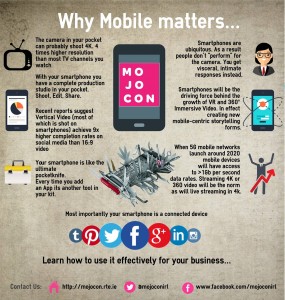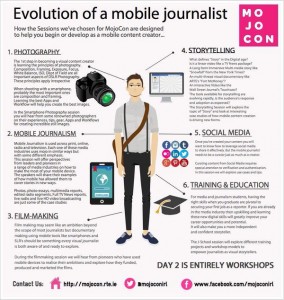Mobile PR
Over the last year or so, there’s been a huge surge in interest in MoJo – or mobile journalism to give it the Sunday name – but it hasn’t translated into something in the public relations community. Why is this? Surely we’re not still all running about on first gen Blackberries and Nokia N95s? Or is just that we don’t like #MoPR as a hashtag?
Or is the industry vastly under-trained for non-text forms of communication?
WHAT IS MOJO?
It’s doing journalism more or less exclusively on a mobile device. Now, writing an article isn’t overly complicated (with or without an external keyboard) and ditto for sending text updates to Twitter and Facebook or images to Snapchat and Instagram but MoJo mostly concentrates on the art of filming and editing a story purely on a mobile device and the tools that make that job a lot easier.
The advantages are obvious – you can film quickly, do a quick edit and have the material live while others are still packing up their kit and going back to the car. You can have first mover advantage and all the eyeballs that brings.
But it’s not just about that. Sometimes it’s a lot more convenient to shoot with a small camera. Not every video effort needs a crew like Capture Media (sorry guys!).
So why aren’t more PR practitioners doing it?
Three reasons: being a little stuck in the past, a little untrained and a little bit of fear
THE HANGUP OVER MOBILE PR ISN’T THE MOBILE PART…
Traditionally PR – regardless of it being public relations, press relations or media relations – has been about words. Agencies and in-house teams spent days crafting – and getting approval for – press releases that would then be sent out to newspapers, magazines, TV and radio stations. These would later be joined by websites.
Sometimes there would be a visual or two – which the client had paid extra for – but often the hope was that the TV or radio media outlet would send along a photographer or a video camera crew: the PR team were specialising in words.
And so it remains to this day.
But while text formats have changed – paragraphs are normally a lot shorter, there’s more white space and sub-headings to make material easier to read on mobiles for example – video (and indeed, even just audio) is seen as one of those things that requires a) extra bodies and b) extra fee from the client. And that does no-one any favours. The quicker the industry fully accepts that the monthly fee for providing content can mean more than words, the better.
Perception also plays a part in this. Some fear that turning up to to a client with nothing more than an iPhone 6+, a few RØde mics and a tripod will see them dismissed as not taking the client seriously – despite the fact that the phone (and the camera) will be, in many companies, probably the most advanced pieces of equipment that they have.
Worrying about the size of your camera and your gear misses the point. Good PR is about offering good advice and the right tools for each job. If you have a simple press release, there’s very little to adding a straightforward video from the person named in the press release. Get them in a room with a plain background apart from a company logo on the wall and have them talk – not to the camera but off to the side. That doesn’t need a RED digital camera.

EIGHT REASONS TO CONSIDER MOBILE PR
- You must know by now that YouTube is the second largest search engine in the world (and owned by the largest search engine in the world)
- People might cut and paste from a press release but 99% of people either embed a YouTube video or not, there’s no editing or distortion of message
- In many fields, doing a quick video with each press release will give your client a USP as their competitors will still be text-only
- It gets your clients more relaxed with speaking in front of a camera, meaning that when Buzzfeed, Vice, the BBC, Sky or ITN come calling they’ll be more comfortable looking
- It’s adding to your skillset – and that’s always good for CPD
- The platforms that are growing the most are either primarily video or allow for video. Look at Snapchat and Instagram. Even look at Twitter. Tweets with video and images look more interesting than the plain text tweets
- You can get SEO benefits
- Using a video as well as text adds transparency and authenticity to a company. People can see that the words have been spoken by a person in authority and aren’t just some anonymous spokesman PR quote
Now, this isn’t to suggest that the larger filming experts are out of a job – far from it. What it means is that you save these experts for the big jobs – the large press releases, the special announcements and the annual reports – stories that can go beyond the easy shot and straightforward edit.

MOBILE PR VIDEO TIPS
- Planning is still essential. Make sure the client and you know exactly what you want them to achieve. Work out what you want in each video and if it can be done with a one man #mojo setup or if you need a larger crew
- Manage expectations. Not every news outlet will use your footage – but many will if they are running the story. Also bear in mind you aren’t just shooting for the TV media but also people looking at the story online and on YouTube
- Don’t shoot for too long – most people won’t watch for more than 90 seconds
- Good sound is essential and, as such, you should consider external mics, perhaps even ones with headphone attachments
- Consider tripods and external lighting too
- Whatever kit you end up with, test it in multiple cases so you know what it can do and what it can’t do. Most cameraphones are terrible in low-light situations so avoid interviewing your CEO at midnight
- Check out what other people are using. Not all cameraphones are created equal. You can do this on Android as well as iOS but bear in mind some cameraphones are one step up from two tin cans and a piece of string
- Make sure the text around the video is aligned to SEO goals
- Just like a press release and tweets, make sure it’s timely
HOW DO YOU GET STARTED?
- You’ll learn by doing and working out what you are actually good it. I can shoot great video on an iPhone 6+ but my preference is still to edit on a MacBook Pro or an iPad as I prefer the larger screen
- Look at what people are saying on the various #mojo and #mojocon groups online
- Watch a lot of what has already been done
- Play with a lot of the apps and tools to see what ones are right for you
Guest post by Craig McGill (@craigmcgill)
Thanks to @MojoConIRL for the images
